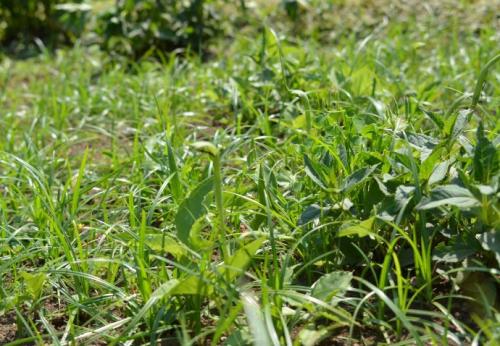Planting technique of Pinellia ternata: the planting method of Pinellia ternata: the difficulty of planting Pinellia ternata
The tuber of Pinellia ternata is the source of the traditional Chinese medicine Pinellia ternata, because it is poisonous, so it is mostly used after processing. This picture is taken from the traditional Wikipedia, not the individual I planted.

The better-known relatives of Typhonium divaricatum are commonly known as Pinellia ternata (Pinellia ternata). Pinellia ternata generally grows in the shade and dampness of the flat land, which is a very common weed, but although Pinellia ternata itself is also distributed in Taiwan, as far as I know, the distribution is above middle altitude, and the number of ethnic groups is relatively small, which is not as common as Pinellia ternata.
But will buy Pinellia ternata, this is not the case at all.
At the beginning, the residence sent by Pinellia ternata to the flat in Taichung was at the turn of winter and spring, so the growth was OK. Although the old plants have been apoptotic, many new strains have emerged one after another and formed many buds, which makes me feel that planting Pinellia ternata seems to have a bright future.
Unexpectedly, two or three weeks later, after helping him change the basin, all the Pinellia ternata died suddenly, and the beads and tubers planted were silent, and there was no intention of taking on new buds. At that time, I inquired about the data and found that there would be this kind of "falling seedling" after Pinellia ternata was maladjusted. Relying on the fact that the buds and tubers were still there, and when he adapted, he would naturally sprout, so I let him go without too much worry.
Only this, that is, a month or two later, a bunch of horse land and chicken mother worms that specialize in humus appeared in the basin. Seeing these bugs, my heart has intuitively believed that those beads and tubers have turned into spring mud and humus and hopeless.
But I was so lazy that I didn't bother to dump the insect breeding group, so I piled him in the most corner of the balcony as a water plate for other potted plants, so he spent the spring, summer and autumn in silence.
At the turn of autumn and winter, I was surprised to find that the figure of Pinellia ternata appeared silently in other potted plants, and then two weeks later, the basin, which was pressed by me at the bottom, suddenly appeared a bunch of Pinellia ternata buds, quietly announcing that he was still alive.
With the arrival of waves of cold, the weather became colder and colder, and Pinellia ternata became more and more luxuriant. the buds that emerged were almost the number of bulbs and tubers buried in a different pot at that time. I understood that Pinellia ternata was so patient that he could survive in a wet, rotten and worm-infested environment for so long, the only problem he faced was that the weather on the flatlands of Taichung was so hot that he got a little heatstroke.
Then the south wind of spring came in from the sea, and the temperature was getting higher and higher, the size was a little petite, and the leaves felt that Pinellia ternata, which had not yet fully unfolded, also fell to the ground one by one, which confirmed the idea in my heart. He really does not adapt to the temperature of the flat land and cannot survive in spring, summer and autumn, so unless he is in an air-conditioned greenhouse or in a mountain above 1000 meters above sea level. Otherwise, according to this trend, the size of Pinellia ternata growing every winter will only get smaller and weaker, so it is impossible for Pinellia ternata to grow normally all the year round, or even to be planted and produced in large quantities.
- Prev

Is the queen or the queen with wings? How does the queen reproduce?
Do you raise ants? What do you know about the queen? let's take a look at it. 1. Does the queen have wings? In general, queens do not have wings, and breeding ants will break their wings soon after mating, or some post-breed ones.
- Next

Is Taiwan famous for strawberries? What are the benefits of strawberries?
Is Taiwan famous for strawberries? It is very famous. Let's learn about the mystery of strawberry origin in Taiwan. What are the benefits of strawberries? The mystery of the origin of strawberries in Taiwan: French strawberries originally came from the wild in North America, but commercial cultivation and mass production began in France in the 18th century.
Related
- On the eggshell is a badge full of pride. British Poultry Egg Market and Consumer observation
- British study: 72% of Britons are willing to buy native eggs raised by insects
- Guidelines for friendly egg production revised the increase of space in chicken sheds can not be forced to change feathers and lay eggs.
- Risk of delay in customs clearance Australia suspends lobster exports to China
- Pig semen-the Vector of virus Transmission (4)
- Pig semen-the Vector of virus Transmission (3)
- Five common causes of difficult control of classical swine fever in clinic and their countermeasures
- Foot-and-mouth disease is the most effective way to prevent it!
- PED is the number one killer of piglets and has to be guarded against in autumn and winter.
- What is "yellow fat pig"? Have you ever heard the pig collector talk about "yellow fat pig"?

